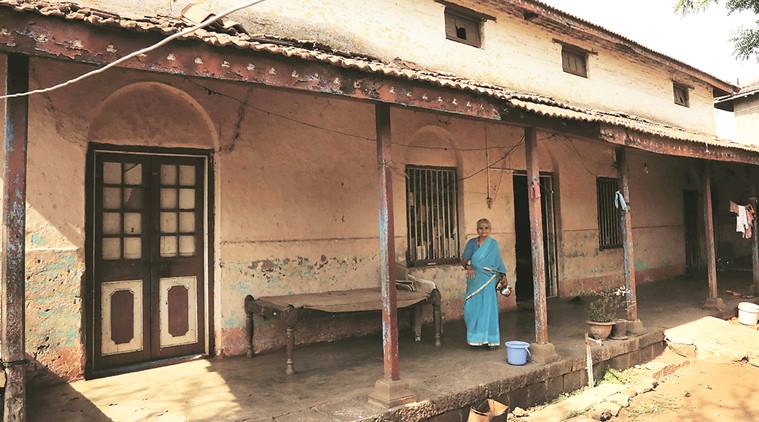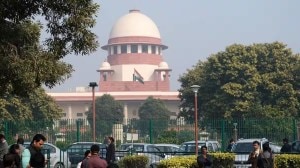- India
- International
Living in protected monument, Satara family awaits verdict on their home
Court to decide if the seven-room bungalow, about a century old, where Ambedkar is said to have lived as a schoolboy should be acquired for a memorial
 Dr.Babasaheb Ambedkar Banglow at Sadar Bazar, Satara. The high court was hearing a petition filed by Laxman Aamne challenging the governments contention and claiming that the property belonged to him and not the Ambedkar family. Express Photo by Amit Chakravarty
Dr.Babasaheb Ambedkar Banglow at Sadar Bazar, Satara. The high court was hearing a petition filed by Laxman Aamne challenging the governments contention and claiming that the property belonged to him and not the Ambedkar family. Express Photo by Amit Chakravarty
Within the crumbling walls of Amne Bungalow lives Kamal Amne, 82, a wrinkled woman with moist eyes. “I have seen my children take their first steps here,” she points to the verandah. “All my memories are attached with this house. Where will we go if a memorial is erected on this land?”
The Amnes are the current owners of a seven-room bungalow, about a century old, where Dr Bhimrao Ambedkar supposedly lived as a schoolboy. Located in a quiet lane in the city of Satara, about 260 km from Mumbai, the bungalow has been in the spotlight ever since the Amnes’ battle against the state government was heard in the Bombay High Court earlier this year, in response to a government proposal to turn the bungalow into an Ambedkar memorial monument, demanding evidence that the architect of the Indian Constitution at all lived in this house.
For the Amnes, the trouble began 13 years ago when Dalit groups in the region, who refer to the Amne Bungalow as Ambedkar House, began to talk about a memorial to Dr Ambedkar in the house of his childhood. Their claim to the bungalow is now backed by a state government decision to acquire the property, a quaint structure with a roof of Mangalore tiles, where Ambedkar lived from 1896 till 1904.
In 2005, Laxman Kalu Amne, Kamal’s husband and the owner, filed a petition in court after the bungalow was declared a protected monument, automatically curtailing the Amnes’ right to modify or redevelop the house. Since then, every time a stranger knocks, Kamal stands guard, almost expecting to be evicted.
In the seven rooms on the 2,950-square-metre plot, Laxman, wife Kamal, son Uday and daughter-in-law Smita live on the meagre earnings of a grocery store and the rent they get from a few tenants. The majority of the plot is actually vacant, barren except for a single drooping tree standing guard. The bungalow leaks in the monsoons but the Amnes have neither money nor government permissions to repair the heritage structure, they complain. A hint of pink paint on the outer walls and turquoise blue on the inner walls are remnants of the last paint job, done decades ago.

Laxman Amne bought the house in 1970 for Rs 30,000, when he still worked as a government official. He borrowed some money from friends and relatives to buy it, says Smita. He constructed five toilets, four rooms and a compound wall to the existing bungalow. Later, the weddings of his son and daughter were held here, as his grand-daughters’. “This was an empty structure, we brought furniture and made it a home,” says Kamal.
In 2004, Amne decided to partner with a real estate developer to construct a residential building on the plot. It was then that talk of the memorial gathered force. “ The day the complex’s bhoomipoojan was to happen, locals came and assaulted Amne,” remembers Ajeet Jagtap, a local.
According to RPI leader Ashok Gaikwad, it is their party’s wish to see a memorial wherever Ambedkar lived or studied. “Our forefathers told us Ambedkar lived there. His mother Bhimabai was buried in the next lane where another memorial is coming up,” he says.
At the turn of the century, the house was owned by Satara-based Dhanjishi Kapoor, who purchased it for Rs 1,075 from Ram Subhedar. Locals believe Ambedkar’s father, a military teacher, lived on rent in this modest bungalow. As a kid, Ambedkar would walk nearly 6 kilometres a day to Pratap Singh High School in Rajwada Chowk.
Records are unclear on how long Ambedkar lived in Satara. At Pratap Singh High School, records show him as a student from 1900 till 1904, till Class V. Before that he attended Camp School, Satara. The record is laminated and locked in headmaster S G Mujawar’s office where clerk Nikhil Chaugule says tourists sometimes visit for a slice of Ambedkar’s childhood.
Amne argues in his petition that there is no proof in the school or municipal records to show Ambedkar lived in this bungalow. The school’s register has a single entry in cursive showing Bhima Ramji Ambedkar as a student who joined in Class I in 1900. A signature in Hindi alongside belongs to Ambedkar.
The state government has told the court through affidavits that Ambedkar’s father Ramji Maloji Sakpal was working in Satara during that period and lived in the said property, when the young Ambedkar was a student. While the school general register does not mention where he lived, he would have naturally lived with his father, one affidavit said. Another affidavit filed earlier by state agencies said “it would be preposterous to assume he lived anywhere excepting in this house.”
The evidence of its famous former occupant notwithstanding, the bungalow can fetch next to nothing in the market, its commercial value having dipped. While the petition remains to be disposed of in the HC, the Amnes hope the absence of any other material evidence will help them retain their home.
Meanwhile, this April 14, on Ambedkar Jayanti, as Satara city was draped with posters of Ambedkar, local residents put up tents and a scaffolding for a stage outside Amne’s main gates. The sound of drums and slogans continued all day.
“It’s not new. Every day, either in a big vehicle or on foot, a visitor comes knocking,” Smita says. There is a steady stream of curious visitors — MLAs, MPs, tourists, locals — who want to take a look at where Ambedkar lived. Also, Republican Party of India (RPI) rallies in Satara originate from this bungalow. A tiny slum cluster with a large population of Ambedkarites keeps vigil, ensuring no demolition or construction takes place.
The courts will eventually decide on the bungalow’s fate, but the 90-year-old Amne knows one thing. A new Shivaji museum constructed in Satara stands shut, attracting no visitors. He wonders if the fate of his home will be similar.
Apr 16: Latest News
- 01
- 02
- 03
- 04
- 05






































